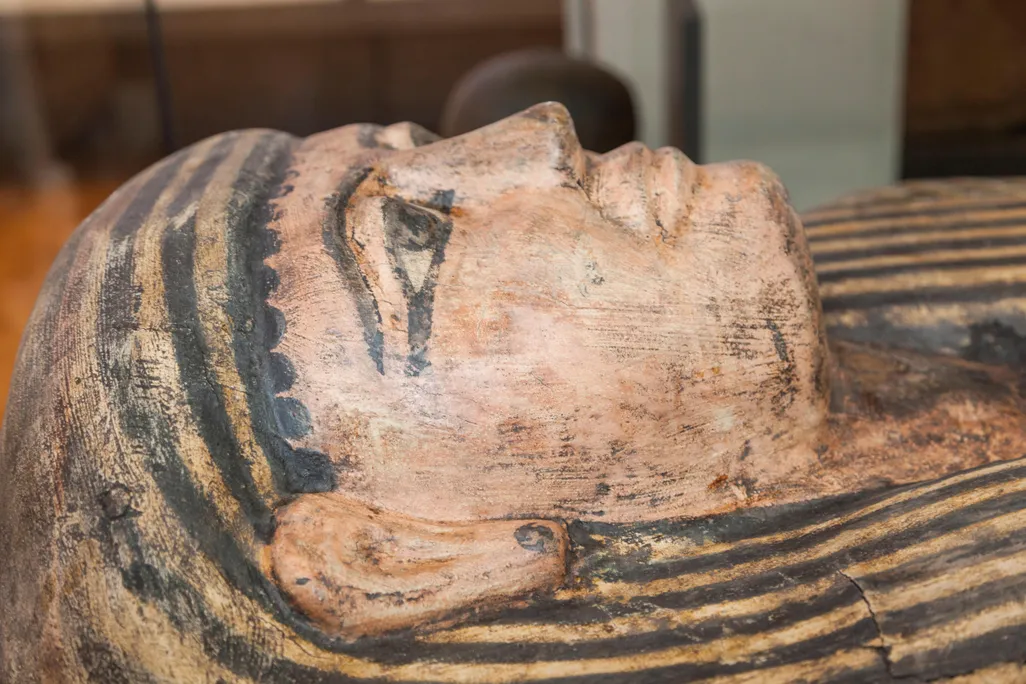
The Manchester Museum in England is inviting guests to share feedback on Asru, an ancient Egyptian woman whose body was unwrapped 200 years ago

The mummified remains of an ancient Egyptian woman named Asru have been on display at the Manchester Museum since 1825.
Prisma by Dukas Presseagentur GmbH / Alamy Stock Photo
Should museums display mummified human remains? One institution in England has decided to ask visitors for their take on this ethical dilemma.
The Manchester Museum is encouraging guests to share their thoughts on whether it should continue to display the mummified remains of an ancient Egyptian woman named Asru, reports Chris Osuh for the Guardian.
Asru’s mummified body was unwrapped in Manchester in 1825—and her remains have been on display in some form ever since.
“In that time, we have also changed as a museum and are thinking more about how we care for people,” according to a sign atop a feedback box next to Asru’s display case. “To mark 200 years since her unwrapping, we would like to start a conversation about her future.”
Visitors are invited to share their opinions in person or online between now and the end of August.
“We haven’t made any firm decisions on next steps yet but intend to use the feedback to inform elements of our approach,” a museum spokesperson tells the Art Newspaper’s Gareth Harris.
Asru was an elite woman who lived 2,700 years ago in the ancient city of Thebes, the precursor to modern-day Luxor. Her father, Pa-Kush, held the high-status role of document scribe. Based on his name, which means “the Kushite man,” scholars think he hailed from what is now southern Egypt or northern Sudan.
Translated literally, Asru’s “unusual” name means “her arm is against them,” according to a blog post written by Campbell Price, the museum’s curator of Egypt and Sudan. Experts think this phrase may be a reference to a powerful female deity, but the origins of her name remain a mystery.
After Asru died at approximately 60 in around 650 B.C.E., her mummified body was enclosed inside two painted wooden coffins.
In the early 19th century, the body and coffins were acquired by the brothers Robert and William Garnett. They were the sons of John Garnett, a Manchester cotton merchant and slave trader. The Garnetts donated Asru to the Manchester Natural History Society, which later became the Manchester Museum.
After Asru’s body was unwrapped and put on display, the writer George Head visited the society’s museum to see “the Egyptian damsel” in 1834, according to Price’s blog post.
“[She] lay entirely divested of her cerements; the colors of her portrait within the center wooden case perfectly vivid, and bundles of blue bugles and coarse linen cloth in good preservation,” Head wrote.
Ever since Asru’s body arrived in Manchester, most of the focus has been on her health, the techniques used to mummify her body and the public’s reactions to her display, Price writes. Now, the museum’s leaders are thinking more about whether they should continue to display her body at all.
The Manchester Museum is not the only institution grappling with such tensions. Around the globe, museums—including the Smithsonian—are working to develop policies surrounding the ethical treatment of human remains.
Harvard University, for instance, recently removed a book binding made from human skin from public display. Meanwhile, the Chau Chak Wing Museum at the University of Sydney in Australia has also withdrawn fragments of mummified bodies.
“For hundreds of years, body parts in museum collections have been treated as objects,” said Melanie Pitkin, a senior curator at the Chau Chak Wing Museum, in a statement at the time. “We have become so accustomed to seeing them on show that we often forget they once belonged to living people.”

/https://tf-cmsv2-smithsonianmag-media.s3.amazonaws.com/accounts/headshot/SarahKuta.png)







